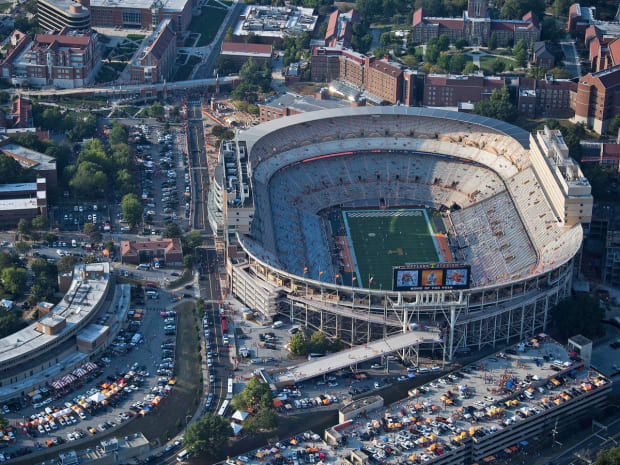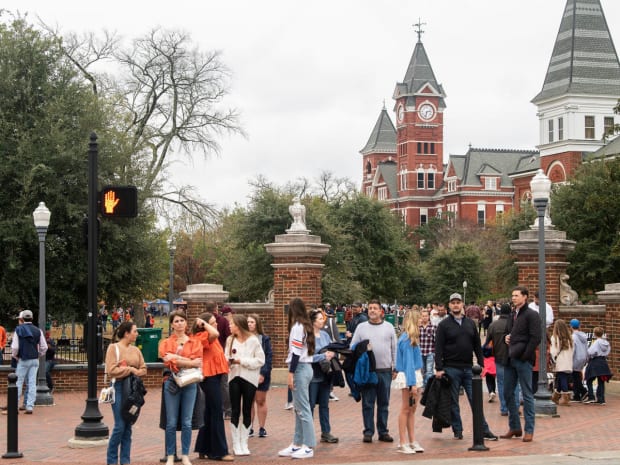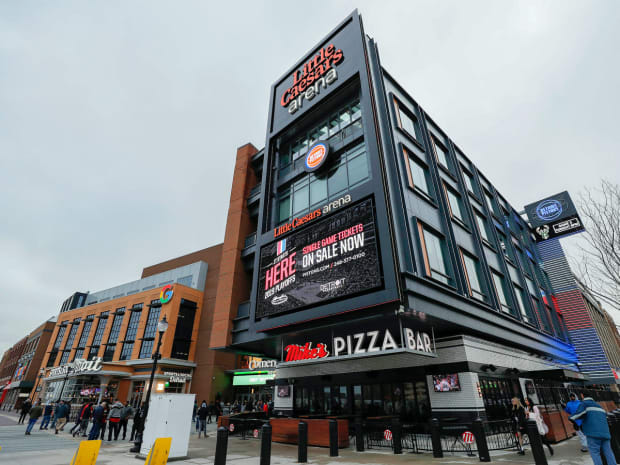Even with a pleasant mountain breeze swirling through the foothills of the Smokies, Zack Roskop had to close his doors and windows once 3:30 struck. The game of the millennium was in town.
Sixth-ranked Tennessee welcomed No. 3 Alabama to Knoxville; the third Saturday in October finally had postseason ramifications for the first time in nearly two decades.
Thirty-three years a Knoxvillian and owner of Knox Brew Hub in the city’s downtown, Roskop knows exactly how loud Neyland Stadium gets on any given Saturday, much less this one. He and his diehard patrons couldn’t have the outcome spoiled by the seismic crowd noise and celebratory fireworks otherwise audible from the hallowed ground, located less than a mile away.
Roskop’s preventative measures did just enough to prevent Neyland’s triumphant roar and a final smattering of fireworks from permeating his bar. Thirty seconds later, as CBS showed Chase McGrath’s game-winning field goal flutter through the uprights, the Knox Brew Hub erupted into unashamed tears and indiscriminate hugs.
In a brief, clairvoyant moment, Roskop turned to his bartenders with a message of caution— “Buckle up; in about 45 minutes it’s gonna just be mass chaos”—before ringing the last call bell to declare that the next round was on the house.
Sure enough, tens of thousands emerged from the Neyland Greenway shrouded in a billowing cloud of cigar smoke. A sea of orange and white flooded Knoxville’s dense downtown—its tributaries fueled by Roskop’s bar and just about every other establishment around—and united in chants of “It’s great to be a Volunteer.”
Neyland Stadium lies at the heart of Knoxville both figuratively—the town of about 190,000 grinds to a halt on game days—and geographically. Nestled within the southeastern corner of the campus and overlooking the mighty Tennessee River, the greenway and red-brick architecture creates short, pleasant walks to the bustling downtown (18 minutes) or the Cumberland Strip (12 minutes).

Caitie McMekin/News Sentinel/USA TODAY Network
On game days, this proximity creates a fluid sea of all things Tennessee football—Roskop doesn’t give directions to first-timers at Rocky Top, advising them simply to find parking near downtown and “follow the stream.”
“It’s definitely electric, truly an encompassing environment,” says James Tourville, owner of the Literboard and SouthSide Garage bars in Knoxville. “I would say it’s hard to replicate it anywhere else in the nation, with how many people get into the stadium and find their way into the surrounding area, and walkability is a large part of that.”
The urbanism of Neyland Stadium is largely unrivaled in U.S. sports—a nation of once-concrete, now chic venues encircled by moats of asphalt—finding much of its stiffest competition right at home in the Southeastern Conference and around the college football landscape.
“College football promotes urbanism and promotes pedestrian social behavior in ways that almost no other activities do,” says Tim Chapin, dean of the College of Social Sciences and Public Policy at Florida State. “That’s true both on a university campus and I’d say in society generally.”
Good urbanism is a rather nebulous term more dependent on context and location than an idyllic gold standard—for example, Starkville will always look a bit different than New York or Tokyo.
But in the eyes of Tim Kellison, director of the Center for Sport and Urban Policy at Georgia State, there are several general criteria for creating good urban spaces: walkability, less reliance on cars, connection to public transportation, accessibility, adaptability and, especially when looking at stadiums, a contribution to the sense of space.
Most SEC stadiums trace their lineage back to the earliest eras of U.S. sport—only Kentucky’s Kroger Field was constructed after 1940. These were periods when these aforementioned urbanist traits were nonnegotiables for stadium design and city life more generally. Stadiums needed to be accessible by foot or by public transport and quickly became extensions of their surrounding neighborhoods, best exemplified by the iconic jewel box ballparks that once dotted the downtowns of major U.S. cities.
The widespread adoption of the automobile and flaring racial tensions saw white, economically mobile Americans flee to the suburbs, and many professional sports teams followed their key demographic into cookie-cutter venues far or disconnected from the city center. Take the Philadelphia Phillies, who abandoned the French Renaissance facade and vibrant Swampoodle neighborhood of Connie Mack Stadium for vacuous Veterans Stadium along the Delaware Expressway in 1971. SEC programs resisted this suburban migration, keeping their stadiums as the cathedrals of campus and the urbanist oases that formed around them.
The American Enterprise Institute has a handy tool that tells you if a given location is within a 10-minute walk of at least six different establishments, ranging from restaurants to supermarkets to hardware stores. And despite the average SEC college town being home to around 175,000 residents, all stadiums in the conference bar one (you guessed it, Kentucky) pass; only 63% of NFL franchises meet that same standard.
With a majority of fans commuting from across the largely rural South, cars are the primary mode of transportation on game days. But while most professional stadiums feature desolate swaths of surface parking, SEC drivers generally find parking much farther removed and experience the atmosphere on foot.
“For SEC games you’re parking on a far side of campus and you’re not necessarily unhappy about that,” Kellison says. “You probably have strong bonds, not just to the stadium or the team, but also to the infrastructure, buildings, quads or the ovals that you can either retrace your steps on or introduce to your kids or grandkids.”

Jake Crandall/USA TODAY Network
Chapin compares SEC game days to the experience at Disney World. It’s a sea of typically nonmobile people motivated to walk everywhere they can because of the unique and captivating atmosphere.
Narrow, pleasant corridors lined with local flora weave between memorable buildings for students and alumni alike, guiding fans from their tailgate to the stadium. Vibrant downtowns swelling with personality and authenticity often lie less than a mile away—open wide for VolSacks (Capri Sun and Vodka) at the Fort Sanders Yacht Club just a half mile from Neyland Stadium—and this all occurs amidst an intoxicating swirl of community and local pride.
“It’s a hypersocial experience,” Chapin says. “Eighty-thousand people come and sort of have one big party, not just inside the stadium but outside of it. There’s a really neat sort of celebration of football as a means of bringing us back together and how good design matters in that.”
Despite the almost religious role these stadiums play on SEC campuses, they’re guaranteed to be in use on only six to seven Saturdays out of the year. For football, it becomes particularly important to find alternate uses for the venue, or to “activate the space,” as Mark Rosentraub, professor of Urban Planning at the University of Michigan, puts it.
“You need to try and figure out how to make a neighborhood vital when we have this anchor that could have as few as ten to twelve events a year,” Rosentraub says. “Each market situation is different, but you’ve got to organize your thinking in the correct way: How do I activate the space?”
This principle takes a number of unique but effective forms throughout the SEC. Florida’s Ben Hill Griffin Stadium, commonly known as The Swamp, is open to the public on weekdays during the school year. Students and residents can study, exercise and hang out in the iconic stadium, while professors can swap classroom monotony for orange-and-blue terraces.
At Texas A&M, more than 25,000 people pile into Kyle Field every Friday night—no ticket required—to cheer on their Aggies, and university offices, lecture halls and research facilities are integrated into venues around the conference.
“The great thing about university campuses is that they come with lots of opportunities for other uses,” Chapin says. “So they’re activating [the space] in a way that professional sports teams only wish they could.”
And even beyond these more subjective social elements, urbanist stadia seem to correlate with concrete economic benefits for universities, as well.
“We had a really good study that showed well-designed, well-integrated stadiums within a university campus are, in the long run, more successful economically,” Chapin says. “The attendance at the stadium doesn’t ebb and flow as much based upon the performance of the team.”
Roskop, who grew up on Peyton Manning mania and national championship expectations, recalls that during Tennessee’s 15 years of futility it was the game-day experience that kept him involved with the program.
Conversely, Chapin points to the University of Miami’s Orange Bowl (now Hard Rock Stadium) as an example of this phenomenon. Through garnet-and-gold-tinted glasses, he admits that when Miami football shines, it's hard to find a better environment in the country to watch a game.
But during the 2022 season, when the 5–7 Hurricanes struggled to score more than a couple of touchdowns on most game days, students and alumni have evidently found it hard to justify the hourlong commute from Coral Gables. The U drew 60,000 fans just once this season, against in-state rival FSU. Miami is one of 23 FBS football programs that plays home games more than a mile from campus—only one of those 23 (South Carolina) is from the SEC.
With a surging reurbanization movement halted just temporarily by the COVID-19 pandemic—urban populations outpaced suburban ones from 2010 to ’16 for the first time since 1950—came a certain vindication for SEC football and the surviving urban venues across the country.
Sports are coming back downtown—and not just in a technical sense like the old Minneapolis Metrodome or Three Rivers Stadium, but this time with a human scale, entrances that interface with pedestrian-friendly streets and loads of mixed-use development on adjacent lots.

Raj Mehta/USA TODAY Sports
Cities like Sacramento, Columbus and Detroit have used new downtown stadiums and arenas to spearhead urban revival projects. Teams and municipalities around the country are recognizing the power of the “last mile,” the swarm of pedestrian activities that occurs within a square mile of a stadium, akin to the “stream” Roskop described in front of Neyland Stadium.
But after a 50-year divorce with the downtown and a continued pursuit of the almighty dollar, cultural reintegration into the city center has been a tougher task. Franchises often purchase the surrounding real estates themselves, and teams like the Atlanta Braves and Texas Rangers have spurned the downtown altogether, creating an artificial last mile deep into the suburbs. All of this has levied accusations of inauthenticity and sterility against these “ballpark districts,” stifling the opportunity for real community expression.
So as the U.S.’s ballparks and arenas continue to reclaim the urban form and its stadiums slowly begin to embrace this density—even Los Angeles and SoFi Stadium are getting in on the last mile with Hollywood Park set to open this year—the blueprint for effective, time-tested and uniquely American stadium urbanism lies exactly where you wouldn’t think to look.







